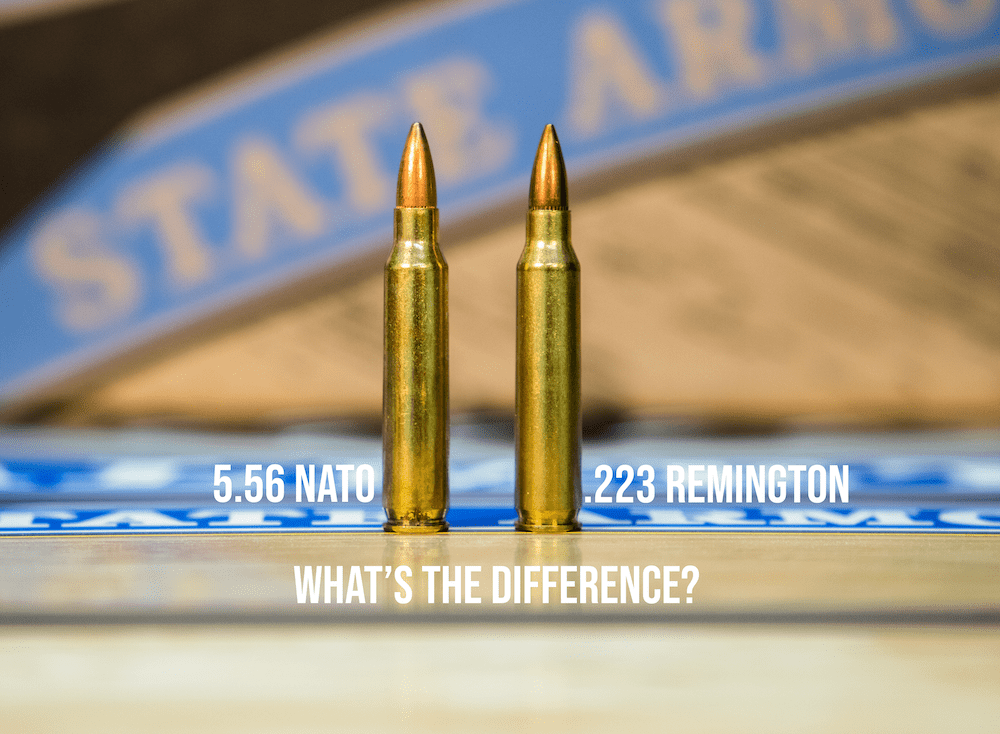.223 vs 5.56 Explained in Plain English
Here’s the .223 and 5.56 side-by-side:

5.56 NATO vs. .223 Remington (Photo by PalmettoStateArmory)
Notice a difference? Not really.
They’re the same size. They look very similar. But there’s a HUGE difference invisible to the eye:
Pressure.

5.56 NATO vs. .223 Remington side-by-side (Photo by PalmettoStateArmory)
In fact, the 5.56 NATO is pretty much a ‘buffed up’ .223 Remington. Which means it can shoot faster and harder than the .223. This is why the military uses it. And that’s why I use it in my AR-15 along with the best AR 15 scope.
However, that doesn’t mean you can use a 5.56 NATO in a .223 chamber. If you do, your gun can possibly be damaged (and harm you).

It may not blow up this bad, but man…this is BAD.
Why is that?
The .223 chamber’s simply not built for THAT much power.
Instead, ONLY chamber 5.56 NATO in a 5.56 chamber and a .223 ammo in a .223 chamber. However, you can safely chamber a .223 ammo in a 5.56 chamber.
That’s because the 5.56 chamber can fit and withstand the .223 ammo. In comparison, the .223 chamber can only fit the 5.56 chamber but not withstand its pressure. That’s why…
The AR-15’s of Today Are Different
Gun manufacturers caught on. They no longer offer AR-15s in a .223 Remington chambering.
As a result, every AR-15 of today is chambered in either a 5.56 NATO, 300 Blackout cartridge or 6.5 Grendel cartridge.
So, even if you used a .223 remington in a 5.56 NATO — you’ll be completely fine. It was only in the past when gun manufacturers used to make .223 chambered AR-15s.
However, that’s no longer the case. But despite that, people still talk about the magical…
.223 Wylde
People say this cartridge is the ‘Goldilocks cartridge’ of the .223 and the 5.56.
The reason?
Supposedly, the .223 Wylde chamber can fire BOTH the 5.56 NATO and .223 rem. However, there’s a teeny little problem:
The .223 Wylde doesn’t exist.

The .223 Wylde is like Moaning Myrtle from Harry Potter. Not real.
Sure: Bill Wyde designed the chamber…but it was never really used in real-life. So let’s put an end to this ‘.223 Wylde’ cartridge. It’s never been a thing.
And with that…
Here’s The Bottom Line On .223 vs 5.56
Simply put:
Don’t use 5.56 ammo in a .223 chamber. It’s incompatible.
However, you can use a .223 in a 5.56 NATO chamber. It’s compatible.
As a quick recap, here’s a table to summarize the compatibilities:

.223 and 5.56 NATO Compatibility Table
And that’s all there is to .223 vs 5.56. Simple enough, right?
Yep, but let’s face it: even though it’s cake, people will still make the .223 vs 5.56 a freaking ROCKET SCIENCE.
They’ll throw in words like ‘trajectory’, measurements, and talk about ‘muzzle velocity’. Ignore all the mumbo jumbo. Just look at the table above. That’s it.
Now that you understand the difference between te .223 vs 5.56, which one will you choose?
Maybe you’ll choose the .223? Or the 5.56?
Either way, let me know in the comments down below.
Author Bio:
Richard Douglas is the founder of Scopes Field, a blog where he reviews the best scopes and guns on the market. He’s been featured on various magazines and publications like NEWSREP, ODU Magazine, Boyds Gun Stocks, Burris Optics, JPFO and so much more.
Latest posts by Tactical Gun Review (see all)
- Bow hunting – an unforgettable experience – April 24, 2025
- Is MagnaCut the Next Breakthrough in Knife Steel? – December 17, 2024
- The Importance of Proper Gun Cleaning and Maintenance – October 30, 2024

Leave a Reply